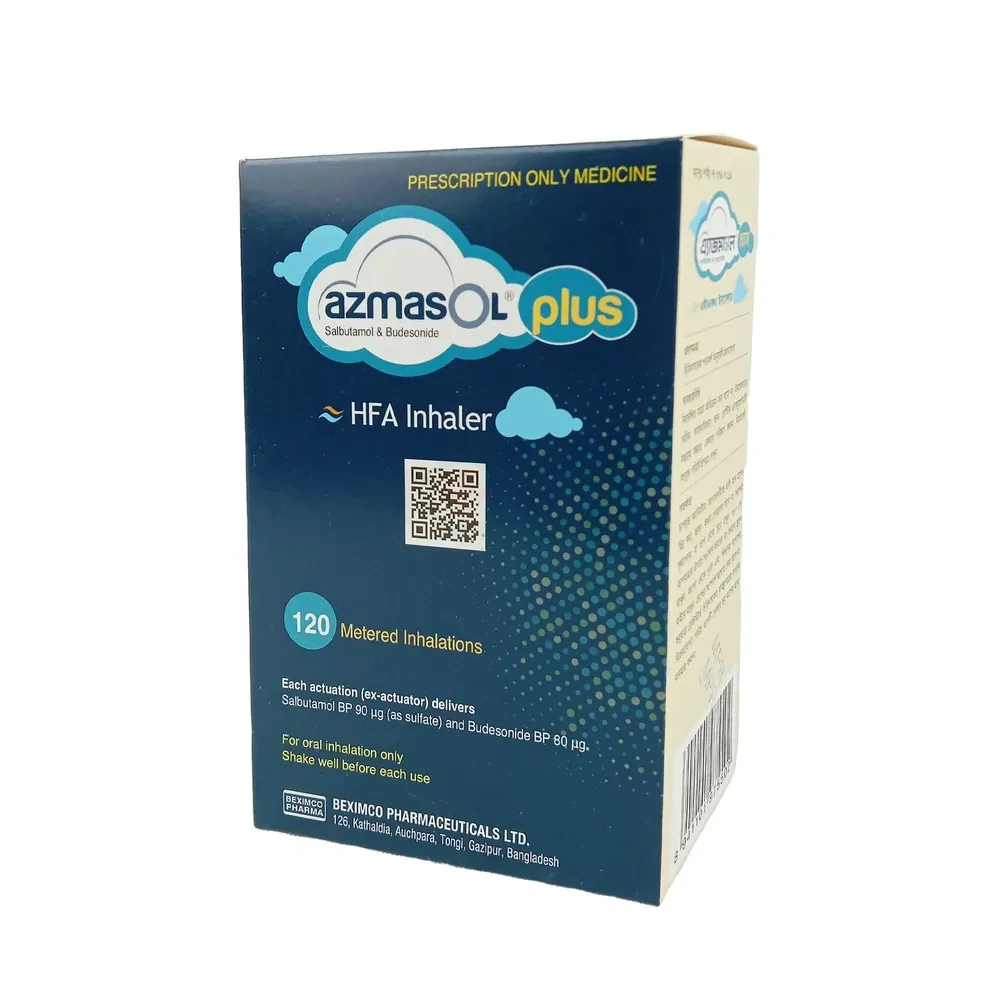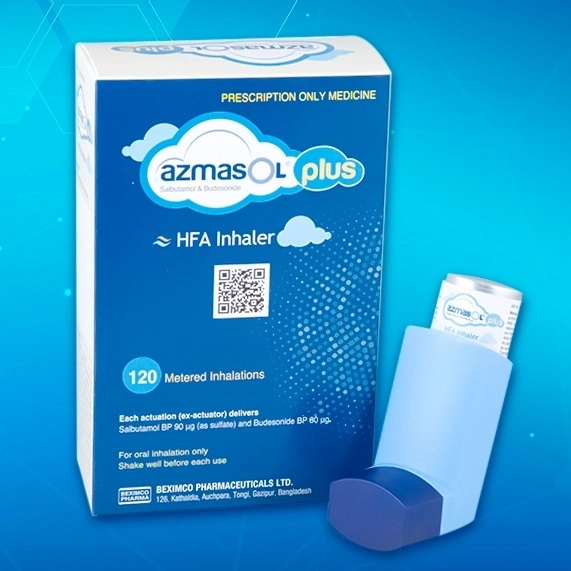Azmasol Plus Metered-Dose Inhaler (MDI)
Pack Images
(90 mcg+80 mcg)/puff
120 metered doses:
৳ 350.00
Indications
This is indicated for the as-needed treatment or prevention of bronchoconstriction and to reduce the risk of exacerbations in patients with asthma 18 years of age and older.
* রেজিস্টার্ড চিকিৎসকের পরামর্শ মোতাবেক ঔষধ সেবন করুন
Pharmacology
This is a combination of salbutamol, a beta2-adrenergic agonist and budesonide, a corticosteroid, indicated for the as-needed treatment or prevention of bronchoconstriction and to reduce the risk of exacerbations in patients with asthma 18 years of age and older. Salbutamol relaxes the smooth muscles of all airways, from the trachea to the terminal bronchioles, while budesonide has a wide range of inhibitory activities against multiple cell types and mediators involved in inflammation.
Dosage & Administration
The recommended dosage of this inhaler is salbutamol 180 µg and budesonide 160 ug (administered as 2 actuation of this inhaler) as needed for asthma symptoms by oral inhalation. Do not take more than 6 doses (12 inhalations) in a 24-hour period. Prime this inhaler before using for the first time. To prime this inhaler, release 4 sprays into the air away from the face, shaking well before each spray. This inhaler must be re-primed when the inhaler has not been used for more than 7 days, is dropped or after cleaning. To re-prime this inhaler, release 2 sprays into the air away from the face, shaking well before each spray.
* রেজিস্টার্ড চিকিৎসকের পরামর্শ মোতাবেক ঔষধ সেবন করুন
Contraindications
This is contraindicated for patients showing hypersensitivity to salbutamol, budesonide, or to any of the excipients.
Side Effects
Significant adverse reactions may include: deterioration of asthma, paradoxical bronchospasm, cardiovascular effects. hypersensitivity reactions, including anaphylaxis, hypokalemia, immunosuppression and risk of infections, oropharyngeal candidiasis, hypercorticism and adrenal suppression, reduction in bone mineral density, glaucoma and cataracts, effects on growth in pediatric patients.
Pregnancy & Lactation
Pregnancy: There are no adequate and well-controlled studies with this inhaler in pregnant women to inform a drug-associated risk. However, available data from epidemiological studies and postmarketing case reports of pregnancy outcomes following inhaled salbutamol use do not consistently demonstrate a risk of major birth defects or miscarriage. Reviews with budesonide use in pregnant women have not identified a drug-related risk of major birth defects. miscarriage or other adverse maternal or fetal outcomes.
Lactation: There are no available data on the effects of with this inhaler on the breastfed child or on milk production.
Lactation: There are no available data on the effects of with this inhaler on the breastfed child or on milk production.
Precautions & Warnings
Asthma may deteriorate acutely over a period of hours or chronically over several days or longer. If the patient continues to experience symptoms after using this inhaler or requires more doses of this inhaler than usual, this may be a marker of destabilization of asthma and requires evaluation of the patient and their treatment regimen.
This inhaler can produce paradoxical bronchospasm, which may be life threatening. If paradoxical bronchospasm occurs following dosing with this inhaler, it should be discontinued immediately, and alternative therapy should be instituted. this inhaler, like other drugs containing beta-adrenergic agonists, can produce clinically significant cardiovascular effects in some patients as measured by increases in pulse rate, blood pressure, and/or other symptoms. If such effects occur, this inhaler may need to be discontinued. As with other inhaled drugs containing beta-adrenergic agents, this inhaler should not be used more than the maximum daily as an overdose may result. Clinically significant cardiovascular effects and fatalities have been reported in association with excessive use of inhaled sympathomimetic drugs. Hypersensitivity reactions can occur after administration of salbutamol sulfate and budesonide, components of this inhaler, as demonstrated by cases of anaphylaxis, angioedema, bronchospasm, oropharyngeal edema, rash, and urticaria. Discontinue this inhaler if such reactions occur. this inhaler, like all therapies containing sympathomimetic amines, should be used with caution in patients with convulsive disorders. hyperthyroidism, or diabetes mellitus and in patients who are unusually responsive to sympathomimetic amines Beta-adrenergic agonist medicines may produce significant hypokalemia in some patients, possibly through intracellular shunting, which has the potential to produce adverse cardiovascular effects. Patients who are using drugs that suppress the immune system are more susceptible to infection. Chicken pox and measles, for example, can have a more serious or even fatal course in susceptible patients using corticosteroids. In patients who have not had these diseases or been properly immunized, particular care should be taken to avoid exposure.
This inhaler contains budesonide, an inhaled corticosteroid (ICS), Localized infections of the mouth and pharynx with Candida albicans have occurred in patients treated with ICS agents. Monitor patients periodically. Budesonide, a component of this inhaler, will often help control asthma symptoms with less suppression of hypothalamic-pituitary-adrenal (HPA) function than therapeutically equivalent oral doses of prednisone, Decreases in bone mineral density (BMD) have been observed with long-term administration of products containing ICS. Patients with major risk factors for decreased bone mineral content, such as prolonged immobilization, family history of osteoporosis, post-menopausal status, tobacco use, advanced age, poor nutrition, or chronic use of drugs that can reduce bone mass should be monitored and treated with established standards of care. Glaucoma, increased intraocular pressure, and cataracts have been reported following the long-term administration of ICS, including budesonide, a component of this inhaler. Caution should be exercised when considering the co-administration of this inhaler with long-term ketoconazole and other known strong CYP3A4 inhibitors (e.g.. ritonavir, atazanavir, clarithromycin, indinavir, itraconazole, nefazodone, nelfinavir, saquinavir, telithromycin) because adverse effects related to increased systemic exposure to budesonide may occur. Orally inhaled corticosteroids, including budesonide, may cause a reduction in growth velocity when administered to pediatric patients. The safety and effectiveness of this inhaler have not been established in pediatric patients, and this inhaler is not indicated for use in this population.
This inhaler can produce paradoxical bronchospasm, which may be life threatening. If paradoxical bronchospasm occurs following dosing with this inhaler, it should be discontinued immediately, and alternative therapy should be instituted. this inhaler, like other drugs containing beta-adrenergic agonists, can produce clinically significant cardiovascular effects in some patients as measured by increases in pulse rate, blood pressure, and/or other symptoms. If such effects occur, this inhaler may need to be discontinued. As with other inhaled drugs containing beta-adrenergic agents, this inhaler should not be used more than the maximum daily as an overdose may result. Clinically significant cardiovascular effects and fatalities have been reported in association with excessive use of inhaled sympathomimetic drugs. Hypersensitivity reactions can occur after administration of salbutamol sulfate and budesonide, components of this inhaler, as demonstrated by cases of anaphylaxis, angioedema, bronchospasm, oropharyngeal edema, rash, and urticaria. Discontinue this inhaler if such reactions occur. this inhaler, like all therapies containing sympathomimetic amines, should be used with caution in patients with convulsive disorders. hyperthyroidism, or diabetes mellitus and in patients who are unusually responsive to sympathomimetic amines Beta-adrenergic agonist medicines may produce significant hypokalemia in some patients, possibly through intracellular shunting, which has the potential to produce adverse cardiovascular effects. Patients who are using drugs that suppress the immune system are more susceptible to infection. Chicken pox and measles, for example, can have a more serious or even fatal course in susceptible patients using corticosteroids. In patients who have not had these diseases or been properly immunized, particular care should be taken to avoid exposure.
This inhaler contains budesonide, an inhaled corticosteroid (ICS), Localized infections of the mouth and pharynx with Candida albicans have occurred in patients treated with ICS agents. Monitor patients periodically. Budesonide, a component of this inhaler, will often help control asthma symptoms with less suppression of hypothalamic-pituitary-adrenal (HPA) function than therapeutically equivalent oral doses of prednisone, Decreases in bone mineral density (BMD) have been observed with long-term administration of products containing ICS. Patients with major risk factors for decreased bone mineral content, such as prolonged immobilization, family history of osteoporosis, post-menopausal status, tobacco use, advanced age, poor nutrition, or chronic use of drugs that can reduce bone mass should be monitored and treated with established standards of care. Glaucoma, increased intraocular pressure, and cataracts have been reported following the long-term administration of ICS, including budesonide, a component of this inhaler. Caution should be exercised when considering the co-administration of this inhaler with long-term ketoconazole and other known strong CYP3A4 inhibitors (e.g.. ritonavir, atazanavir, clarithromycin, indinavir, itraconazole, nefazodone, nelfinavir, saquinavir, telithromycin) because adverse effects related to increased systemic exposure to budesonide may occur. Orally inhaled corticosteroids, including budesonide, may cause a reduction in growth velocity when administered to pediatric patients. The safety and effectiveness of this inhaler have not been established in pediatric patients, and this inhaler is not indicated for use in this population.
Overdose Effects
This inhaler contains both salbutamol and budesonide, therefore, the risks associated with overdosage for the individual components described below apply to this inhaler.
Salbutamol: The expected symptoms with overdosage are those of excessive beta-adrenergic stimulation and/or occurrence or exaggeration of any of the symptoms of beta-adrenergic stimulation (e.g., seizures, angina, hypertension or hypotension, tachycardia with rates up to 200 beats/minute, arrhythmias, nervousness, headache, tremor, muscle cramps, dry mouth, palpitation, nausea, dizziness, fatigue, malaise, insomnia, hyperglycemia, and metabolic acidosis), Hypokalemia may also occur.
Budesonide: If used at excessive doses for prolonged periods, systemic corticosteroid effects such as hypercorticism may occur.
Salbutamol: The expected symptoms with overdosage are those of excessive beta-adrenergic stimulation and/or occurrence or exaggeration of any of the symptoms of beta-adrenergic stimulation (e.g., seizures, angina, hypertension or hypotension, tachycardia with rates up to 200 beats/minute, arrhythmias, nervousness, headache, tremor, muscle cramps, dry mouth, palpitation, nausea, dizziness, fatigue, malaise, insomnia, hyperglycemia, and metabolic acidosis), Hypokalemia may also occur.
Budesonide: If used at excessive doses for prolonged periods, systemic corticosteroid effects such as hypercorticism may occur.
Therapeutic Class
Combined bronchodilators
Storage Conditions
Pressurized canister, do not puncture, break or incinerate even when empty as the canister may explode. Avoid exposure to direct sunlight or heat. Clean your inhaler regularly as per directions. Do not store above 30°C. Keep in a dry place. Protect from light and keep out of the reach of children. Keep away from eyes.
Use within six months after removing from the foil pouch: For best results, the canister should be at room temperature before use. Shake well before each use.
Use within six months after removing from the foil pouch: For best results, the canister should be at room temperature before use. Shake well before each use.
Pack Images: Azmasol Plus (90 mcg Inhaler


